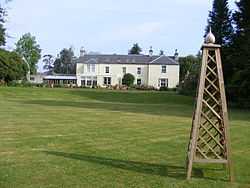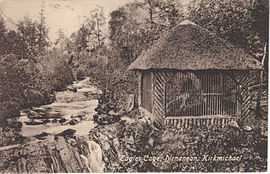Dirnanean House

Dirnanean House is part of a private, traditional Highland estate located near Enochdhu in Moulin parish, Blairgowrie, Perth and Kinross, Scotland, 10 miles ENE of Pitlochry. The Dirnanean estate is situated adjacent to the 64 mile waymarked Cateran Trail.
History of the Estate
A 1588 charter record states that Andrew Small was granted the lands of Dirnanean in Strathardle by John, the 5th Stewart Earl of Atholl.[1] By the time James Small (1835–1900) inherited the estate on the death of his father, Patrick, Dirnanean had been passed from father to son for nine generations.[1] When James Small died without a direct heir, the ownership of Dirnanean transitioned to a series of his nephews until Francis Keir Balfour, the owner of neighboring Kindrogan House, purchased the estate in 1926. A distant Small family cousin through his mother, Amelia Jane Keir, Francis Keir Balfour continued the Small family ownership of Dirnanean into the 1970s.
Dirnanean is now privately owned by a non-relative.
In 1790, Kirkmichael, Scotland musician Robert Petrie (1767–1830) published several Highland music pieces with "Mrs. Small of Dirnanean" in their title. The compositions were published in "Petrie's Collection of Strathspey Reels & County Dances".[2]
Smalls of Dirnanean


The Smalls are a sept of the Scottish Clan Murray of Atholl.[3]
The Small family motto is "Ratione non ira", which translates to "By reason not rage".[4] The Small family crest is branch of palm, properly erect.[5] A gold button bearing an erect palm surrounded by the Small family motto was recently dug up in a garden plot on the Dirnanean estate.
The Small family Coat of arms is described as "Per fesse, wavy, gu. and arg., a lion passant sa., pierced through with a daggar, in bend, ppr. entering at shoulder, hilted, or", which translates to, divided in half horizontally (in the manner of a fess or band), wavy, gules (red) and argent (silver), a lion walking with a forepaw raised, sable (black), pierced through with a dagger, in bend, proper entering at shoulder, hilted, gold.[5]
A number of notable individuals are descendants or related by marriage to the Smalls of Dirnanean.
- Rev. Robert Blair, Scottish minister
- Duncan Cameron, owner of The Oban Times newspaper and inventor of The "Waverley" nib pen
- Mary Cameron, Scottish painter
- General Sir Archibald Campbell, 1st Baronet, GCB, administrator of the colony of New Brunswick, Canada
- General Sir John Campbell, 2nd Baronet, Campbell Baronetcy of New Brunswick, Canada
- Sir Conrad Laurence Corfield, British official and a political secretary of Lord Mountbatten
- William Purdie Dickson, Professor of Divinity at the University of Glasgow
- Daniel Dow, traditional Scottish musician and composer
- Charles Falconer, Baron Falconer of Thoroton
- Sir John Ireland Falconer, former Lord Provost of Edinburgh, 1944-1947
- Mrs. Alexander Fraser, aka Caroline Rosetta Small Fraser, Victorian era novelist
- Sir Reginald Michael Hadow, British diplomat
- Dr. James W. Inches, former Police Commissioner of Detroit, Michigan
- Flora Macaulay, editor of The Oban Times Newspaper
- John MacDonald of Garth, Canadian fur trader
- Rolland Macdonald, Canadian lawyer and judge
- James Macgregor, (1808-1858), British politician and businessman
- William McGillivray, Canadian fur trader
- Andrew Munro, fellow, lecturer in mathematics and bursar at Queen's College, Cambridge
- Sir William Nairne, Lord Dunsinane, 5th Baronet of Nairne
- Monica Poole, English wood-engraver
- Dr. Charles Ransford, Fellow at the Royal College of Physicians, Edinburgh and early advocate of homoeopathy
- Patrick Francis Robertson, British politician and businessman
- Alexander Small, Scottish army surgeon and correspondent of Benjamin Franklin
- Charlotte Small, early Canadian explorer
- Henry Beaumont Small, Canadian civil servant and author
- James Small, Factor of forfeited Straun Estates
- James Small, Laird of Dirnanean
- John Small, (1726–1796), active in the American Revolutionary War
- Dr. John Small, (1823-1879), British Deputy Surgeon General
- John Small, (1828–1886), Librarian of Edinburgh University for 32 years
- Lt. Col. John James Snodgrass, (1796-1841), British military officer and author
- Charles Spalding, (1783-1783), Edinburgh confectioner and improver of the diving bell
- General the Hon. Sir Augustus Almeric Spencer, G.C.B., third son of Sir Francis Spencer, 1st Baron Churchill
- Joan V. Stiebel, MBE, Jewish refugee worker
- David Thompson, (1770-1857), early Canadian explorer
- John Sen Inches Thomson, (1845-1933), Scottish whaler and sealer, ship owner, captain and author
Queen Victoria's Visits
Queen Victoria passed through the lands of Dirnanean in 1865 and again in 1866, on her way from Balmoral Castle to Dunkeld via the Spittal of Glenshee. Her visit in 1865 included a brief stop at Dirnanean House before a more extended visit at Kindrogan House.[1]
Today, Dirnanean House provides hikers on the Cateran Trail a hut for lunch or shelter very near the spot where Queen Victoria stopped for a picnic in 1865.[6]
The Perthshire Eagle

For 37 years, until its death in 1908, an eagle was kept in captivity in a metal and thatched cage next to the Dirnanean Burn.[7] Taken when young from its nest near the Kirkton of Glenisla,[7] the eagle was fed mainly on game by the estate staff.
The Perthshire Eagle was a popular Perthshire attraction during its residence at Dirnanean. Several postcards depicting the eagle in its cage next the Dirnanean Burn were issued to draw Victorian travellers to the Dirnanean area.
Partial remnants of the eagle's cage can still be seen along the Dirnanean Burn walk.
Features
Dirnanean Garden
The estate's traditional highland garden area includes 1.5 hectares of garden plantings with 7 hectares of policies located 1,000 feet above sea level.
Features within the garden include a refurbished summer house on the front lawn, a walled garden, a burn walk with cascades, a traditional estate kitchen garden with an orchard, a greenhouse and poterage, and a small museum of garden tools discovered during the refurbishment of the garden and the grounds.
Peacocks and guineafowls can often be seen roaming the grounds, and a Wellingtonia (Sequoiadendron giganteum) specimen tree bordering the front lawn is estimated to have been planted around 1870. [8]
The garden is accessible by the public for a small fee.
-

Front Lawn
-

Garden Museum
-

Wellingtonia Speciman Tree Behind Refurbished Summer House
Dirnanean Burn
One of the finest features of the estate is the Allt Doire-nan-Eun (Scottish Gaelic: Stream of the Thicket of the Fowl), a stream flowing from high in the Dirnanean hills southwards through a deep wooded gorge on its way to the River Ardle. The burn includes several cascades, a small island and a walking trail that runs parallel to it as it winds through the estate.
-

Estate Stream
-

Burn Cascades
-

Folly & Creature Stone on Burn Walk
-

Field Boulder

Ardle's Grave
Near the former carriage entrance of Dirnanean House, close to the town of Enochdhu, reportedly lie the graves of a Pictish warrior named Ard-fhuil and his henchman. The two fell during a battle near the grave. They appear to have been buried feet to feet, with a large stone at Ardle's head and a lesser one at his henchman's. The origins of the stones are unknown but it is thought unlikely to be prehistoric.[9] Local lore has it that during Victorian times, the laird of Dirnanean buried his horse at the spot as a garden amusement.
References
- ↑ 1.0 1.1 1.2 John, Kerr (1992). Queen Victoria's Scottish Diaries. United Kingdom: Eric Dobby Publishing. pp. 146–159. ISBN 1-85882-018-9.
- ↑ Gatherer, Nigel. "Robert Petrie's First Collection". Retrieved 20 June 2012.
- ↑ "Clan Murray Wikipedia Page". Retrieved 9 November 2011.
- ↑ Burke, Bernard. The General Armory of England, Scotland, Ireland, and Wales, Comprising a Registry of Armorial Bearings from the Earliest to the Present Time, Volume 3. Heritage Books. p. 1179. Retrieved 30 November 2013. "Mottoes, Qu - Sa"
- ↑ 5.0 5.1 Robson, Thomas (1830). The British herald; or, Cabinet of armorial bearings of the nobility & gentry of Great Britain & Ireland, from the earliest to the present time. Turner & Marwood. Retrieved 30 November 2013.
- ↑ "The Cateran Trail". The Upper Lunch Hut. Retrieved 4 December 2012.
- ↑ 7.0 7.1 "Perthshire Captive Eagle". The Scotsman Newspaper, Edinburgh, Scotland. September 21, 1908, Page 6.
- ↑ "Big Tree Country". Retrieved 4 November 2011.
- ↑ "Royal Commission on the Ancient and Historic Monuments of Scotland". Ardle's Grave. Retrieved 27 December 2011.
External links
Coordinates: 56°45′13″N 3°31′48″W / 56.7537°N 3.5299°W